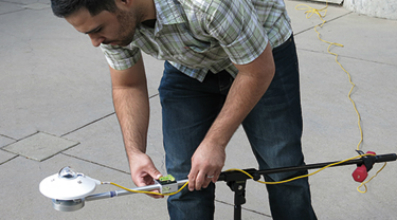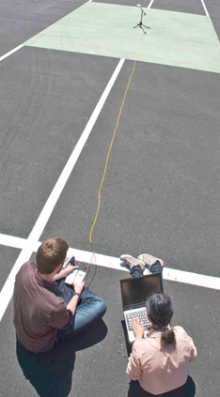In one configuration, a CMP 6 first-class pyranometer is fitted to a CMF 1 mounting fixture that is supported on the boom arm of a microphone stand, 50 cm above the test surface. A counterweight on the other end of the arm helps balance the pyranometer. A METEON data logger is used to record the measurements. The CMP 6 is faced up, then down, to measure incident and reflected solar flux; the process is repeated two more times to check repeatability. The technique is straightforward, but the pyranometer must be oriented and leveled six times in each measurement series.
In a second configuration, the CMP 6 is replaced by a CMA 6 first-class albedometer, which comprises two CMP 6 units integrated back to back and has an integral support rod. This permits simultaneous measurement of incident and reflected fluxes, and the instrument is oriented and leveled only once per measurement series. This makes the CMA 6 more convenient for measurement of albedo. Two METEONs are used to record the incident and reflected irradiance.
While it is common practice to mount an albedometer (or pyranometer) on a portable stand, the LBNL apparatus includes three convenient features. First, the mounting rod is joined to the boom arm of the microphone stand with a quick-release clamp, making it easy to attach and remove. Secondly, the two pairs of signal wires from the CMA 6 are terminated with color-coded banana plugs that connect to color-coded banana sockets on the two METEON data loggers. This reduces the likelihood of operator error.
 Third, and most helpfully, LBNL has added a pair of cross-levels to each mounting rod. These are fitted in an aluminium block that is aligned with the detector surface(s). It can be difficult with a portable apparatus to initially determine from the circular level built into the CMA 6 (or CMP 6) whether the instrument is close to, or far from, horizontal. The bubbles in the cross-level respond more gradually to tilt, making it easier to gauge how close the instrument is to horizontal. This is especially helpful when the CMP 6 is downward-facing, because the bubble level is not visible.
Third, and most helpfully, LBNL has added a pair of cross-levels to each mounting rod. These are fitted in an aluminium block that is aligned with the detector surface(s). It can be difficult with a portable apparatus to initially determine from the circular level built into the CMA 6 (or CMP 6) whether the instrument is close to, or far from, horizontal. The bubbles in the cross-level respond more gradually to tilt, making it easier to gauge how close the instrument is to horizontal. This is especially helpful when the CMP 6 is downward-facing, because the bubble level is not visible.
There is still room for improvement. For example, a stronger and more stable, but still lightweight, stand would permit the use of a longer boom arm. This would increase the accuracy of the albedo measurement by reducing the extent to which the stand is seen by the downward-facing sensor.
For more information on the Group’s activities go to heatisland.lbl.gov.
Article by Ronnen Levinson, Ph.D., Staff Scientist, Heat Island Group, Lawrence Berkeley National Laboratory, Berkeley, California
Berkeley Lab Researchers Showcase Cool Pavement Technology
An example of LBNL’s research that uses the CMA 6 albedometer configuration, is a study of cool pavement technologies. LBNL's Julie Chao describes the study in her article ‘Parking Lot Science: Is Black Best?’
On those sweltering summer days - when it’s too hot to play at the playground, when it seems like you could fry an egg on the pavement, when your car feels like an oven after a couple of hours parked at the mall - it’s not just the beating sun that’s driving up the temperature. It’s our very urban environment, in which most of our paved surfaces are dark, absorbing almost all of the sunlight that shines down on them
 In a typical city, pavements account for 35 to 50 percent of surface area, of which about half is comprised of streets and about 40 percent of exposed parking lots. Most of these streets and parking lots are constructed with dark materials. “It’s amazing how hot these pavements get and how we’ve let them cover most of our urban surfaces,” said Haley Gilbert, a researcher in the Heat Island Group of Lawrence Berkeley National Laboratory (Berkeley Lab). “Because dark pavements absorb almost all of the sun’s energy, the pavement surface heats up, which in turn also warms the local air and aggravates urban heat islands.”
In a typical city, pavements account for 35 to 50 percent of surface area, of which about half is comprised of streets and about 40 percent of exposed parking lots. Most of these streets and parking lots are constructed with dark materials. “It’s amazing how hot these pavements get and how we’ve let them cover most of our urban surfaces,” said Haley Gilbert, a researcher in the Heat Island Group of Lawrence Berkeley National Laboratory (Berkeley Lab). “Because dark pavements absorb almost all of the sun’s energy, the pavement surface heats up, which in turn also warms the local air and aggravates urban heat islands.”
To combat this problem, Berkeley Lab scientists have been studying ‘cool pavement’ technologies. Like cool roofs, which are lighter-colored roofs that keep the air both inside and outside the building cooler by reflecting more of the sun’s energy, cool pavements reflect as much as 30 to 50 percent of the sun’s energy, compared to only 5 percent for new asphalt (and 10 to 20 percent for aged asphalt).
The Heat Island Group has converted a portion of a new temporary parking lot at Berkeley Lab into a cool pavement exhibit that will also allow them to evaluate the products over time. The parking lot provides an opportunity to feature cool pavement coatings that are applied directly to existing paved surfaces.
“An ideal design goal would be a pavement with solar reflectance of at least 35 percent,” Gilbert said. “How you get there will vary by project.”
With the exhibit now open at Berkeley Lab, the scientists will be collecting data to see how the coatings fare over time. A CMA 6 albedometer is used to measure incoming and reflected solar irradiance. The ratio of the two values gives the surface reflectance.
The benefits of cool pavements extend beyond just cooling the local ambient air. They can also impact global warming and energy loads. Dark roofs and dark pavements both contribute to global warming by absorbing large amounts of solar energy stored in sunlight, then radiating the energy back into the atmosphere in the form of heat.
Gilbert added: “Across an entire city, small changes in air temperature could be a huge benefit as it can slow the formation of smog. Just a couple of degrees can also reduce peak power demand, by reducing the energy load from air-conditioning.”
Read the full article at: newscenter.lbl.gov/feature-stories/2012/09/13/parking-lot-science
Lawrence Berkeley National Laboratory addresses the world’s most urgent scientific challenges by advancing sustainable energy, protecting human health, creating new materials, and revealing the origin and fate of the universe. Founded in 1931, Berkeley Lab’s scientific expertise has been recognized with 13 Nobel prizes. The University of California manages Berkeley Lab for the U.S. Department of Energy’s Office of Science. For more, visit www.lbl.gov.